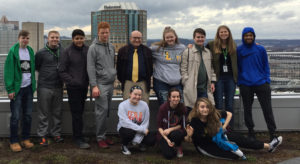 Sitting in the heart of Pittsburgh, the Energy Innovation center stands as a symbol of the changes taking place within the city. Once the Clifford B. Connelley Trade School, the Energy Innovation Center functions as a prototype example of taking an older style building and bringing it into the next century while still keeping the charm it possesses as a landmark of the city of Pittsburgh. On February 23rd, 2018 ten Students and two teachers from Seton LaSalle High School we gave the opportunity to tour the Energy Innovation Center, and see first hand the way a historical monument comes together with a sustainable future model.
Sitting in the heart of Pittsburgh, the Energy Innovation center stands as a symbol of the changes taking place within the city. Once the Clifford B. Connelley Trade School, the Energy Innovation Center functions as a prototype example of taking an older style building and bringing it into the next century while still keeping the charm it possesses as a landmark of the city of Pittsburgh. On February 23rd, 2018 ten Students and two teachers from Seton LaSalle High School we gave the opportunity to tour the Energy Innovation Center, and see first hand the way a historical monument comes together with a sustainable future model.
 The Energy Innovation Center is still being used to educate but is now gone away from the trades that the city of Pittsburgh was once known for. Their mission is to contribute to socially responsible workforce development, foster energy and sustainable technology advancement, and assist in job creation through a commitment to diversity, innovation and comprehensive education. It is referred to as a “green” energy center, a center for research and job training in the energy fields, including new, sustainable energy systems. Wind energy was the topic of our STEM Tour and a particular interest to the students working on a classroom book project, The Boy, the Bird, and the Turbine.
The Energy Innovation Center is still being used to educate but is now gone away from the trades that the city of Pittsburgh was once known for. Their mission is to contribute to socially responsible workforce development, foster energy and sustainable technology advancement, and assist in job creation through a commitment to diversity, innovation and comprehensive education. It is referred to as a “green” energy center, a center for research and job training in the energy fields, including new, sustainable energy systems. Wind energy was the topic of our STEM Tour and a particular interest to the students working on a classroom book project, The Boy, the Bird, and the Turbine.
Within the walls of the Center you’ll find corporations and startups, and universities like Penn State and Pitt. Soon UPMC will be moving in and using a new state of art surgical suite in order to train sanitary operating room practices. While they didn’t get to step inside, a tour guide pointed out the Electric Power Technologies Laboratory led by Dr. Reed. The lab focuses on advanced electric power grid and energy generation, transmission, and distribution-system technologies; power electronics and control technologies; renewable energy systems and integration; smart grid technologies and applications; and energy-storage development.
Training at the Energy Innovation Center focuses on industry required certifications and skills Courses are currently available in
- Energy Safety Passport
- Introduction to the Trades`
- Scalo Professional Roofing Training
- Surface Restoration and Treatment
- Underground Utility Job Readiness Training (Coming Soon)
- Fundamentals of Project Management
- Essentials For Project Management
 The Introduction to the Trades class is a unique introductory overview to building trades. During the six-week course, participants are exposed to a wide range of skilled occupations, through field trips to state-of-the-art union training facilities, hands-on activities, and meetings with expert craftspeople representing 18 local trade unions. In addition, the classroom portion introduces key job readiness skills needed to begin a career in the building and construction trades. Upon completion, successful participants will have the option of taking the next step and applying for union apprenticeship.
The Introduction to the Trades class is a unique introductory overview to building trades. During the six-week course, participants are exposed to a wide range of skilled occupations, through field trips to state-of-the-art union training facilities, hands-on activities, and meetings with expert craftspeople representing 18 local trade unions. In addition, the classroom portion introduces key job readiness skills needed to begin a career in the building and construction trades. Upon completion, successful participants will have the option of taking the next step and applying for union apprenticeship.
The students were amazed by the environmentally friendly technical innovations that are quickly becoming the norm for the city. Innovations including water soaking asphalt in the parking lot and a vertical wind turbine to help supplement energy for the building. On the outside the box type of idea for the cooling system of the building, Joseph Rouse had this to say “I like this place the best. It is so cool how they did the big containers of ice in the swimming pool for the air conditioning of this building!”
Dr. Anthony DeCaria, the students’ science teacher at Seton LaSalle High School, summed up the true purpose of the EIC when he said “It seems like a good place to launch an idea. It is a great environment for the cross-pollination of thoughts and collaboration.”
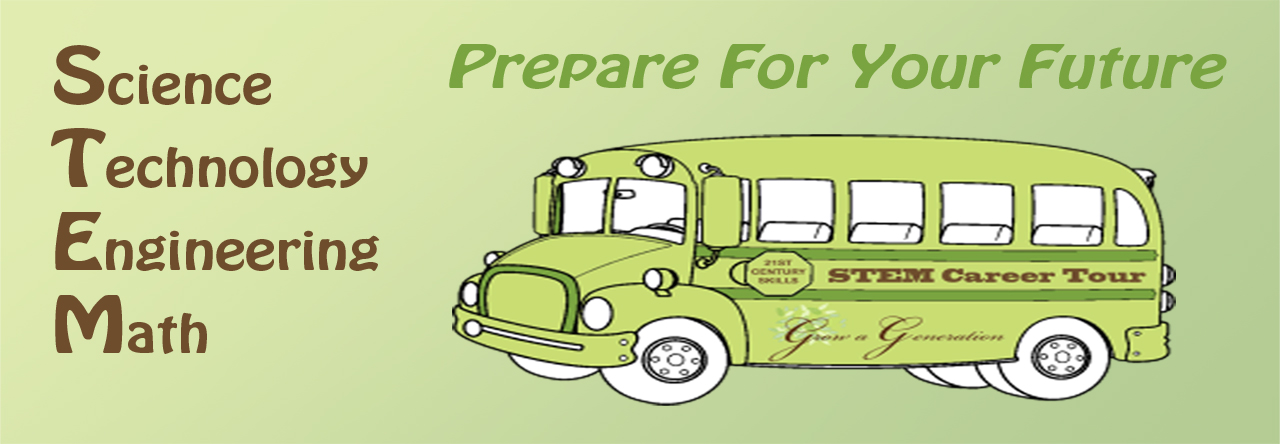
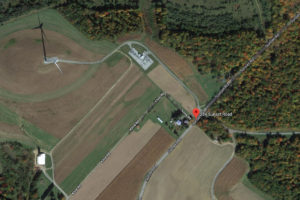 On February 23rd, 10 Students from Seton La Salle High School and a pair of their teachers visited a wind farm located in the heart of Patton Township. They stepped from the bus into driving rain and a wind that blew against them stinging their faces. They met, huddled together among the cold and rain, with Michael Hoffman the Highland Assistant Site Manager for Everpower Wind Holdings.
On February 23rd, 10 Students from Seton La Salle High School and a pair of their teachers visited a wind farm located in the heart of Patton Township. They stepped from the bus into driving rain and a wind that blew against them stinging their faces. They met, huddled together among the cold and rain, with Michael Hoffman the Highland Assistant Site Manager for Everpower Wind Holdings.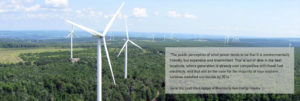

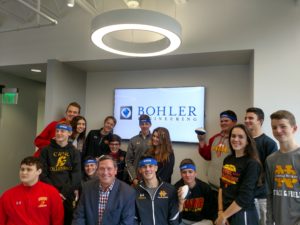 On November 17, The Students of Mrs. Steiniger’s Biology class from Cardinal Wuerl North Catholic arrived at the brand new Pittsburgh office of Bohler Engineering for a STEM Career tour all about sustainability. Bohler has been consulting on land development projects for a few decades now, and while not always demanded, they do consistently attempt to add as many green touches as possible to their projects.
On November 17, The Students of Mrs. Steiniger’s Biology class from Cardinal Wuerl North Catholic arrived at the brand new Pittsburgh office of Bohler Engineering for a STEM Career tour all about sustainability. Bohler has been consulting on land development projects for a few decades now, and while not always demanded, they do consistently attempt to add as many green touches as possible to their projects.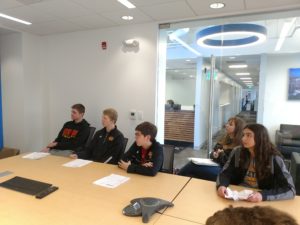 Mr. Takacs was also able to share knowledge of other sustainable projects of note and interest within the city, including a recently constructed building that can be opened up and cooled passively with natural air currents.
Mr. Takacs was also able to share knowledge of other sustainable projects of note and interest within the city, including a recently constructed building that can be opened up and cooled passively with natural air currents. ovember 17th Mrs. Steiniger’s Biology class from Cardinal Wuerl North Catholic High School toured the Center For Sustainable Landscapes at Phipps Conservatory, as part of Sustainability Stem Career Tour. The Center For Sustainable Landscapes is one of the greenest buildings in the world, meeting the requirements of the Living Building Challenge the strictest classification for a green building project.
ovember 17th Mrs. Steiniger’s Biology class from Cardinal Wuerl North Catholic High School toured the Center For Sustainable Landscapes at Phipps Conservatory, as part of Sustainability Stem Career Tour. The Center For Sustainable Landscapes is one of the greenest buildings in the world, meeting the requirements of the Living Building Challenge the strictest classification for a green building project.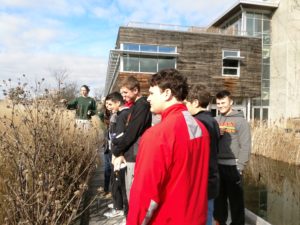
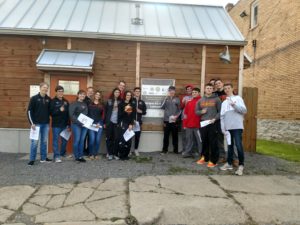 My name is Tim Roos, I’m a sophomore at North Catholic, and I recently went on the sustainability field trip at North. On the field trip, we stopped at the Oasis Farm Fishery in Homewood. The main topic of the tour as sustainability, and how Oasis has incorporated it into its function. Homewood is what is considered a food desert, which is an area that has no access to fresh fruits or vegetables.
My name is Tim Roos, I’m a sophomore at North Catholic, and I recently went on the sustainability field trip at North. On the field trip, we stopped at the Oasis Farm Fishery in Homewood. The main topic of the tour as sustainability, and how Oasis has incorporated it into its function. Homewood is what is considered a food desert, which is an area that has no access to fresh fruits or vegetables.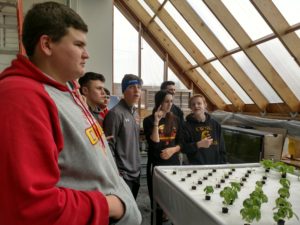 ed sustainable agricultural practices such as aquaponics, but I know so much more now that I went to Oasis Farm Fishery. For instance, I didn’t know that you want the roots of plants to be white, which shows that there is a good amount of oxygen present. Oasis Fishery is using the most with what they’ve got. If the temperature becomes too hot in the greenhouse, they cover the sides with a metal-mesh cover, that reflects 50% of the sunlight and warmth, so the vegetables don’t fry to death. Every so often insects enter the greenhouse and eat away at the crops. Once Casey notices the insect problem, he will introduce a predator to the greenhouse. For example, if aphids are the problem, he would introduce ladybugs.
ed sustainable agricultural practices such as aquaponics, but I know so much more now that I went to Oasis Farm Fishery. For instance, I didn’t know that you want the roots of plants to be white, which shows that there is a good amount of oxygen present. Oasis Fishery is using the most with what they’ve got. If the temperature becomes too hot in the greenhouse, they cover the sides with a metal-mesh cover, that reflects 50% of the sunlight and warmth, so the vegetables don’t fry to death. Every so often insects enter the greenhouse and eat away at the crops. Once Casey notices the insect problem, he will introduce a predator to the greenhouse. For example, if aphids are the problem, he would introduce ladybugs.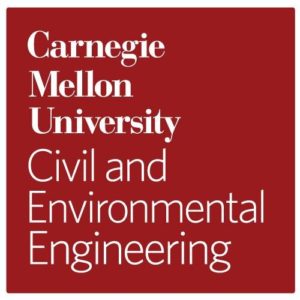 Fifteen students from Cardinal Wuerl North Catholic got the incredible opportunity to travel around the Pittsburgh area and learn first-hand about sustainability and engineering. We heard from many great minds in the fields of engineering and conservation. I was one of these students, and the whole day was eye-opening and I learned an incredible amount of important information. One of our stops involved going to Carnegie Mellon University in North Oakland to learn about what CMU does to be sustainable. Another purpose was to be educated on their engineering major, and how that class involves a lot of environmental engineering and learning about sustainable engineering.
Fifteen students from Cardinal Wuerl North Catholic got the incredible opportunity to travel around the Pittsburgh area and learn first-hand about sustainability and engineering. We heard from many great minds in the fields of engineering and conservation. I was one of these students, and the whole day was eye-opening and I learned an incredible amount of important information. One of our stops involved going to Carnegie Mellon University in North Oakland to learn about what CMU does to be sustainable. Another purpose was to be educated on their engineering major, and how that class involves a lot of environmental engineering and learning about sustainable engineering.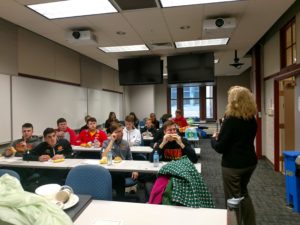 First, we heard from Gwen Dipietro, the instructor of Introduction to Sustainable Engineering at Carnegie Mellon. She talked about her course and what the experiments her students due to preserve biodiversity and remain sustainability. She also talked about her research she completed in Pittsburgh. She researched the tugboats that move coal through the locks and dams of Pittsburgh. Her goal was to see how much coal went through these locks and dams as well as how often these transports occurred. Her teaching assistant, Genna Waldvogel, also spoke about her life as an engineer and how sustainability plays a large part in it. She discussed her research project to get her Masters Degree in Civil and Environmental Engineering. It involved the chemicals in the rivers of Pittsburgh and their possible toxicity. These instructors are great examples of sustainability in engineering and making a choice to try to be as sustainable as possible.
First, we heard from Gwen Dipietro, the instructor of Introduction to Sustainable Engineering at Carnegie Mellon. She talked about her course and what the experiments her students due to preserve biodiversity and remain sustainability. She also talked about her research she completed in Pittsburgh. She researched the tugboats that move coal through the locks and dams of Pittsburgh. Her goal was to see how much coal went through these locks and dams as well as how often these transports occurred. Her teaching assistant, Genna Waldvogel, also spoke about her life as an engineer and how sustainability plays a large part in it. She discussed her research project to get her Masters Degree in Civil and Environmental Engineering. It involved the chemicals in the rivers of Pittsburgh and their possible toxicity. These instructors are great examples of sustainability in engineering and making a choice to try to be as sustainable as possible.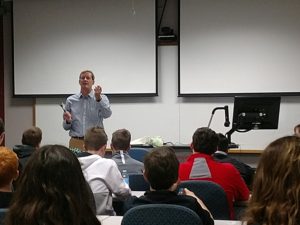 Andrea Rooney, the director of undergraduate programs in the department then spoke. She talked about a variety of topics, one of which being a project that her classes completed. It was all about exploring where each part of a product came from. She used the example of a water bottle and spoke about how the cap, wrapper and, even the ink all come from different places, increasing the carbon footprint needed to make the bottle. In her study, it was found that about six times the amount of water in a water bottle is needed to produce that water bottle. It was very interesting to hear all the seemingly nonexistent things that go into making a water bottle.
Andrea Rooney, the director of undergraduate programs in the department then spoke. She talked about a variety of topics, one of which being a project that her classes completed. It was all about exploring where each part of a product came from. She used the example of a water bottle and spoke about how the cap, wrapper and, even the ink all come from different places, increasing the carbon footprint needed to make the bottle. In her study, it was found that about six times the amount of water in a water bottle is needed to produce that water bottle. It was very interesting to hear all the seemingly nonexistent things that go into making a water bottle. “America is built on energy.”
“America is built on energy.”
